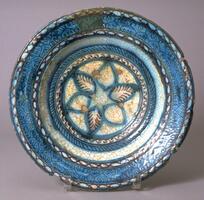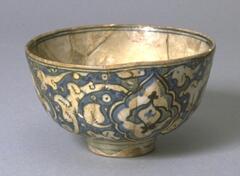11 UMMA Objects
11 UMMA Objects
![This jar has a long and upright mouth with a robust shoulder that give way to a body tapering toward the base. The crane, cloud, pine tree and rock are painted with blue and red copper pigment.<br />
<br />
This jar was produced at a kiln in Bunwon-ri, Gwangju-si, Gyeonggi-do after the privatization of official court kilns in 1883. Ten longevity symbols, including pine trees, rocks, lingzhi fungus, deer, cranes, clouds and bamboo, are decorated in cobalt-blue and copper-oxide pigment was used in parts to decorate the jar. Such jars featuring the ten longevity symbols were often used at events such as elder statesmen’s gathering (giroyeon) and 60th birthday parties (hoegabyeon). Crackles were formed on the mouth and body, which are contaminated with impurities, but it remains intact overall. The foot retains traces of coarse sand supports, but lots of cracks were formed.<br />
[Korean Collection, University of Michigan Museum of Art (2014) p.169] This jar has a long and upright mouth with a robust shoulder that give way to a body tapering toward the base. The crane, cloud, pine tree and rock are painted with blue and red copper pigment.<br />
<br />
This jar was produced at a kiln in Bunwon-ri, Gwangju-si, Gyeonggi-do after the privatization of official court kilns in 1883. Ten longevity symbols, including pine trees, rocks, lingzhi fungus, deer, cranes, clouds and bamboo, are decorated in cobalt-blue and copper-oxide pigment was used in parts to decorate the jar. Such jars featuring the ten longevity symbols were often used at events such as elder statesmen’s gathering (giroyeon) and 60th birthday parties (hoegabyeon). Crackles were formed on the mouth and body, which are contaminated with impurities, but it remains intact overall. The foot retains traces of coarse sand supports, but lots of cracks were formed.<br />
[Korean Collection, University of Michigan Museum of Art (2014) p.169]](/media/W1siZiIsIjIwMjIvMDUvMjUvNjdqd3QzZzEybV9kZWZhdWx0LmpwZyJdLFsicCIsInRodW1iIiwiMjQweDIwMCJdXQ?sha=fecc2783f3328016)
Korean (Korean (culture or style))
Blue-and-white balustrade jar with design of stag, crane, and pine tree
1850 – 1899
Transfer from the College of Architecture and Design
1972/2.81
![Many white porcelain bottles of this type were produced at Bunwon-ri in the 19th century. One side of its body is decorated with a spray of plum blossom, with the stem and flowers rendered in underglaze iron brown and cobalt blue, respectively. The relatively vivid colors of iron and cobalt colors made the decorations highly effective. The entire foot was glazed, while the foot rim retains traces of fine sand spurs. The precipitation of ash deposits on one side has produced pale green spots. However, this is a high-grade object with transparent and well-fused glaze.<br />
[Korean Collection, University of Michigan Museum of Art (2014) p.180] Many white porcelain bottles of this type were produced at Bunwon-ri in the 19th century. One side of its body is decorated with a spray of plum blossom, with the stem and flowers rendered in underglaze iron brown and cobalt blue, respectively. The relatively vivid colors of iron and cobalt colors made the decorations highly effective. The entire foot was glazed, while the foot rim retains traces of fine sand spurs. The precipitation of ash deposits on one side has produced pale green spots. However, this is a high-grade object with transparent and well-fused glaze.<br />
[Korean Collection, University of Michigan Museum of Art (2014) p.180]](/media/W1siZiIsIjIwMjIvMDkvMjQvOWltazR0ZHVoNV9kZWZhdWx0LmpwZyJdLFsicCIsInRodW1iIiwiMjQweDIwMCJdXQ?sha=d577b9f60161a4da)
Korean (Korean (culture or style))
Wine bottle with plum branch design
1850 – 1899
Gift of Bruce and Inta Hasenkamp and Museum purchase made possible by Elder and Mrs. Sang-Yong Nam
2004/1.275

Korean (Korean (culture or style))
Long-necked bottle with plant spray design
13th century
Gift of Bruce and Inta Hasenkamp and Museum purchase made possible by Elder and Mrs. Sang-Yong Nam
2004/1.253
![<p>This is a maebyeong decorated in underglaze iron brown. As the glaze was not su ciently fused during ring, the vase has a bright yellow-brown hue. Two large oral scrolls are decorated on the two sides of the body in iron brown. Its glazed surface is dull due to insu cient fusion and glaze had shivered in many parts, revealing the body. The foot is low but with a wide rim. This type of greenish-brown glazed celadon decorated in iron brown was produced in large quantities around the areas of Jinsan-ri, Haenam-gun, Jeollanam-do.<br />
[<em>Korean Collection, University of Michigan Museum of Art</em> (2014) p.138]</p>
<p>This is a maebyeong decorated in underglaze iron brown. As the glaze was not su ciently fused during ring, the vase has a bright yellow-brown hue. Two large oral scrolls are decorated on the two sides of the body in iron brown. Its glazed surface is dull due to insu cient fusion and glaze had shivered in many parts, revealing the body. The foot is low but with a wide rim. This type of greenish-brown glazed celadon decorated in iron brown was produced in large quantities around the areas of Jinsan-ri, Haenam-gun, Jeollanam-do.<br />
[<em>Korean Collection, University of Michigan Museum of Art</em> (2014) p.138]</p>](/media/W1siZiIsIjIwMjIvMDkvMjQvNHZpenFxYmFocV9kZWZhdWx0LmpwZyJdLFsicCIsInRodW1iIiwiMjQweDIwMCJdXQ?sha=4ab28d8e3f8fc160)
Korean (Korean (culture or style))
Maebyong (Wine Jar) with two plant sprays; misfired
13th century
Gift of Bruce and Inta Hasenkamp and Museum purchase made possible by Elder and Mrs. Sang-Yong Nam
2004/1.254
![Stoneware oil bottle with cup-shaped mouth and body in the shape of a Go gaming piece, or Baduk. The body is decorated with painted floral sprays and covered by celadon glaze.<br />
<p>The bottle is embellished with chrysanthemums with pâte-sur-pâte decorative technique and with the leaves in iron- brown. There are three refractory spur marks on the low foot. It has a dark ground color that appears like deep gray. Glaze on the body is oxidized, producing areas of yellow- brown color. The rim of the mouth shows traces of repair.<br />
[<em>Korean Collection, University of Michigan Museum of Art</em> (2014) p.131]</p>
Stoneware oil bottle with cup-shaped mouth and body in the shape of a Go gaming piece, or Baduk. The body is decorated with painted floral sprays and covered by celadon glaze.<br />
<p>The bottle is embellished with chrysanthemums with pâte-sur-pâte decorative technique and with the leaves in iron- brown. There are three refractory spur marks on the low foot. It has a dark ground color that appears like deep gray. Glaze on the body is oxidized, producing areas of yellow- brown color. The rim of the mouth shows traces of repair.<br />
[<em>Korean Collection, University of Michigan Museum of Art</em> (2014) p.131]</p>](/media/W1siZiIsIjIwMjIvMDkvMjQvM2Fpa3VmaGhidF9kZWZhdWx0LmpwZyJdLFsicCIsInRodW1iIiwiMjQweDIwMCJdXQ?sha=a28205fe02acc94e)
Korean (Korean (culture or style))
Oil Bottle with Chrysanthemum Design
12th century
Gift of Bruce and Inta Hasenkamp and Museum purchase made possible by Elder and Mrs. Sang-Yong Nam
2004/1.239
![<p>This is celadon maebyeong decorated with large foliage spray designs painted in underglaze iron brown in two sides of its body. Such celadon wares decorated with oral scrolls in underglaze iron brown and coated with greenish-brown glaze were generally produced in large numbers in the area of Jinsan-ri in Haenam-gun, Jeollanam-do. The body contains lots of white quarts sand, producing rough surface. The foot is wide and at and ne grains of sand are adhere to it. It is yellow-brown overall, though glaze has gathered towards the base, creating a greener tone.<br />
[<em>Korean Collection, University of Michigan Museum of Art </em>(2014) p.139]</p>
<p>This is celadon maebyeong decorated with large foliage spray designs painted in underglaze iron brown in two sides of its body. Such celadon wares decorated with oral scrolls in underglaze iron brown and coated with greenish-brown glaze were generally produced in large numbers in the area of Jinsan-ri in Haenam-gun, Jeollanam-do. The body contains lots of white quarts sand, producing rough surface. The foot is wide and at and ne grains of sand are adhere to it. It is yellow-brown overall, though glaze has gathered towards the base, creating a greener tone.<br />
[<em>Korean Collection, University of Michigan Museum of Art </em>(2014) p.139]</p>](/media/W1siZiIsIjIwMjIvMDkvMjQvMm83NXZsdXF4OF9kZWZhdWx0LmpwZyJdLFsicCIsInRodW1iIiwiMjQweDIwMCJdXQ?sha=cc643fa3579e7c66)
Korean (Korean (culture or style))
Maebyeong (Wine Storage Bottle) with plant spray design
13th century
Gift of Bruce and Inta Hasenkamp and Museum purchase made possible by Elder and Mrs. Sang-Yong Nam
2004/1.252

Korean (Korean (culture or style))
Small wine bottle with painted design
1400 – 1599
Gift of Bruce and Inta Hasenkamp and Museum purchase made possible by Elder and Mrs. Sang-Yong Nam
2004/1.267
![Most buncheong bottles excavated from tombs have damaged mouth. This bottle, too, has been repaired after complete breakage of its rim. The chemicals used during the restoration have flowed down to the center of the body. The rim of the foot reveals the unglazed body and shows the traces of building the foot. The bottle was produced at a kiln in Hakbong-ri, Gongju-gun, Chungcheongnam-do. Its glaze was thinly applied, thus the iron-oxide pigment and white slip have peeled off in many places.<br />
[Korean Collection, University of Michigan Museum of Art (2014) p.153] Most buncheong bottles excavated from tombs have damaged mouth. This bottle, too, has been repaired after complete breakage of its rim. The chemicals used during the restoration have flowed down to the center of the body. The rim of the foot reveals the unglazed body and shows the traces of building the foot. The bottle was produced at a kiln in Hakbong-ri, Gongju-gun, Chungcheongnam-do. Its glaze was thinly applied, thus the iron-oxide pigment and white slip have peeled off in many places.<br />
[Korean Collection, University of Michigan Museum of Art (2014) p.153]](/media/W1siZiIsIjIwMjIvMDkvMjQvM3J6Nmo0Y2Myel9kZWZhdWx0LmpwZyJdLFsicCIsInRodW1iIiwiMjQweDIwMCJdXQ?sha=98764c6d358a67d9)
Korean (Korean (culture or style))
Buncheong Ware Wine Bottle with painted Ginseng Leaf Design
16th century
Gift of Bruce and Inta Hasenkamp and Museum purchase made possible by Elder and Mrs. Sang-Yong Nam
2004/1.268
![This is an ordinatley jar shaped like maebyeong with a wide mouth. The shoulder is decorated with iron-pained semi-abstract vignette in two places. The decorated design is reddish brown in color, while its background color is pale gray-green. The foot and outer base are thoroughly glazed, on which are placed coarse sand during firing. The walls become thicker towards the base. The glaze was poorly applied. Therefore, the clay body is exposed in some places around the foot, and blisters reracuted ruptures resulted from bursting of the glaze.<br />
[Korean Collection, University of Michigan Museum of Art (2014) p.171] This is an ordinatley jar shaped like maebyeong with a wide mouth. The shoulder is decorated with iron-pained semi-abstract vignette in two places. The decorated design is reddish brown in color, while its background color is pale gray-green. The foot and outer base are thoroughly glazed, on which are placed coarse sand during firing. The walls become thicker towards the base. The glaze was poorly applied. Therefore, the clay body is exposed in some places around the foot, and blisters reracuted ruptures resulted from bursting of the glaze.<br />
[Korean Collection, University of Michigan Museum of Art (2014) p.171]](/media/W1siZiIsIjIwMjIvMDkvMjQvNHJ5NjN5aWs4MV9kZWZhdWx0LmpwZyJdLFsicCIsInRodW1iIiwiMjQweDIwMCJdXQ?sha=aa0bbf315397f04a)
Korean (Korean (culture or style))
Maebyeong (Wine Storage Bottle) with abstract floral spray design
1800 – 1850
Gift of Bruce and Inta Hasenkamp and Museum purchase made possible by Elder and Mrs. Sang-Yong Nam
2004/1.302

Iranian (Iranian)
Shallow bowl with bands of turquoise glaze and central floral pattern
17th century
Transfer from the College of Architecture and Design
1972/2.159
Loading…

